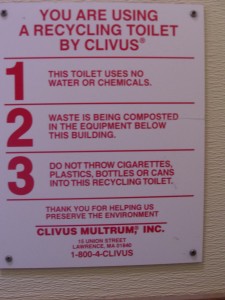 Resource Management
Resource Management
On a daily basis the average American wakes up, brushes their teeth, showers, flushes the toilet, and drives to work. During their lunch break they usually drive somewhere to get a meal, and drive back to work. After work they drive home, make dinner, maybe watch some television or read a book, and then go to bed.
While living on the Gato Verde for about three weeks, we learned a lot about the resources we use on a daily basis and some of the thing we take for granted, like water. Every day we measured how much water was used and calculated the amount of water we used per person per day. On average we had 6 people living on a 42 foot catamaran using 18 gallons per day, or approximately 3gallons/person/day. I assumed this was a significant amount of water to be using, considering it was only used to wash dishes by hand, brush teeth, flush the toilet in the head, and occasionally wash hair. After doing a bit of research I was surprised to learn that the average American per day uses 80-100 gallons of water. Most of this water is used for bathing/showering and flushing a toilet. With such a large amount of water being used every day, by each person, it is astonishing that many of us never think about the amount of water we are using, and where it is coming from. Because water is so accessible to most Americans, it seems that we often forget not only the amount of water that we are using daily, but also the other resources being used so that we can have water at the turn of a faucet.
While it is nice to have the convenience of water at our finger tips, it is important to remember that clean, useable water is not easy to acquire in many parts of the world, and there are many costs associated with using such a large amount of water. Next time you flush your toilet, think about how much water was just use, and how many chemicals will be needed to treat the waste water before it is sent back out into the environment.
Read More
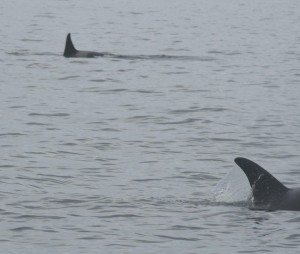
Foraging Behavior?
While there is a lot of information that we do know about the southern resident killer whales, there is so much information that still remains a mystery about these great predators. It has been established that the southern resident killer whales mainly eat Chinook salmon, which makes up 65% of their diet. Research has also shown that Chinook salmon within the home range of the southern resident killer whales are also endangered (Hanson, 2007). In addition to knowing their diet; their family structure, life span, age of sexual maturity, and vocalizations used by these predators are known as well. With all of the knowledge we do have about the southern resident killer whales, there are a lot of things that we can only speculate about. One thing that remains unclear is what the vocalizations of these whales mean.
While on the Gato Verde I focused on one specific question, which was – can killer whale click rates tell us anything about foraging behavior? Researchers have found in several species of toothed whales that there is a relationship between acoustics and foraging behaviors (Simon, 2007). Because so much of a killer whales activities take place under water where visability s limited, this question was particularly hard to answer.
I was unable to find a direct correlation between foraging and click rates from the data I collected, however I am still interested in further exploring this question. Further research on this topic would perhaps give me a more definitive answer, and it would be useful in determining what activities are taking place in their underwater habitat. While the answers I found through my own project were not entirely satisfactory, this project did heighten my curiosities about what the clicks produced by killer whales could be telling us. I would recommend that others explore this topic as well, so that one day we will have a definite answer to what their vocalizations mean.
Read More
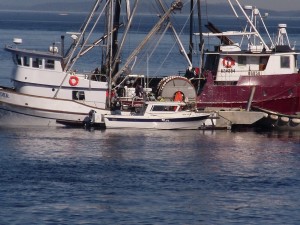 Concerns about overfishing are a pressing issue. Technological advances, have made fishing industries much more efficient. Fish are caught at greater depths, and in much larger numbers. Some scientists have estimated that as much as 90% of large predatory fish including sharks, swordfish, and cod have been removed from the oceans of the world . With so many large predatory fish having been removed from the ocean it may seem that there are plenty of other fish in the sea, however this is untrue for a growing number of fish populations. Other factors, including pollution, fishing methods, and habitat destruction contribute to the decline of many fish populations, including Chinook salmon.
Concerns about overfishing are a pressing issue. Technological advances, have made fishing industries much more efficient. Fish are caught at greater depths, and in much larger numbers. Some scientists have estimated that as much as 90% of large predatory fish including sharks, swordfish, and cod have been removed from the oceans of the world . With so many large predatory fish having been removed from the ocean it may seem that there are plenty of other fish in the sea, however this is untrue for a growing number of fish populations. Other factors, including pollution, fishing methods, and habitat destruction contribute to the decline of many fish populations, including Chinook salmon.
As we have learned, Chinook are the preferred prey of the endangered southern resident killer whales. These salmon are also listed as endangered. Habitat degredation, genetic and ecological impacts from hatchery production, and impacts from hydropower are factors that put these fish at risk. While Chinook salmon make up 65 % of the southern resident killer whales diet, and are of upmost importance to this population of killer whales, they are also consumed by many other marine animals. As specific fish populations become threatened or endangered, so do the predators that depend on them as a food source.
Understanding relationships between predators and their prey is crucial to maintaining, and sustaining the environment in which all living creatures share. Establishing the importance of all members contributing to an ecosystem further emphasizes the importance of practicing sustainability. It is important to remember that the environment in which we live is delicate and can be manipulated easily. It is up to all members of society to establish methods for fishing that will not devastate the environment in which they live, and share.
Read More
A continuation of the study started in 1967 on Lake Ontario was carried out in the Great Lakes (Superior, Huron, Erie, Ontario, and Michigan) to determine the species and abundance of crustaceans and zooplankton during the summer months. Summer was chosen because it is the period when all of the Great Lakes reach maximum temperature and production. This
study focuses on the relationship between temperature and lake eutrophication. Eutrophication occurs when nitrogen and phosphorous levels are increased. The increase in nitrogen and phosphorous levels accelerates the growth of algae and
plants which deplete both oxygen levels and biodiversity.  A general trend was seen in oligotrophic (water poor in dissolved nutrients and rich in dissolved oxygen) Lake Superior to eutrophic Lake Erie. The trend occurring is a significant decrease
of Calanoids and an increased predominance of cyclopoids and cladocerans. This trend raises significant concerns because
calanoids take in energy from phytoplankton and algae, and repackage it for food consumption, making it an intricate part of the food web. In addition to the depletion of calanoids, an increase of cyclopoids and cladocerans (small crustaceans, or fresh water fleas) causes great concern as well. While the Great Lakes show different degrees of progressing eutrophication, previous
limnological studies show a number of pronounced changes in the chemistry and biology in some of these lakes over the past 60 years.
According to Patalas, K., the most significant factor determining the degree of eutrophication is due to human populations inhabiting the basin. While the increased number of species common to all the Great Lakes may be the result of a similar postglacial history of the lakes, this study concludes that differences in total abundance of certain species could be a reflection of the present morphological differences in chemical conditions. It further concludes that human influences on chemical conditions have a greater effect on eutrophication than physical conditions, such as temperature. The phosphorous loading in these lakes
affects nutrient loading. It was determined that removing phosphorous from detergents would decrease the total phosphorous loading by 0.5g/m2. Approximately 60% of phosphorous loads come from the detergents that humans use, and a drastic reduction of phosphorous is necessary to expect some apparent changes in the clarity of the water.
While it may seem that lake eutrophication is only a problem for the ecosystem of a particular lake that is being affected, this is
untrue. Not only does the crash of one ecosystem destroy the life that it once sustained, but it has devastating effects on surrounding, and interconnected ecosystems alike. Because the great lakes form a chain connecting them to the St. Lawrence River which leads to the Atlantic Ocean, the decline of species like calanoids in these lakes has an adverse effect on many animals including baleen whales, bowhead whales, right whales, and fin whales which consume them. It is important to remember that
every environment plays a unique and important role in the intricate and delicate web of life; which is why it is crucial to protect and maintain all natural environments.
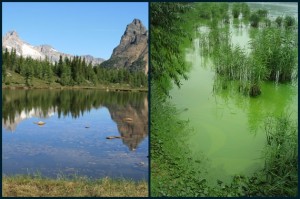
This picture compares a nice clean lake (left), to one which is highly eutrophic (right). I think you get the picture!
Read More
What exactly is sustainability science, and why is it important? According to the United States Environmental Protection Agency (EPA), sustainability is societies ability to meet its current needs in addition to protecting the ability of subsequent generations to meet their own needs. Individuals in society seem to understand the importance of securing resources not only to satisfy their current needs, but also the future needs of their descendants. As individuals and family units, the value of sustainability is immeasurable. Parents and grandparents alike safeguard resources needed to provide adequate care to meet the demands of their offspring. As a society however, we often ignore the impact that our decisions have on those immediately around us, as well as worldwide. This encompasses not only the impact societies decisions have on the human population, but all creatures that share the earths resources with us.
Science is defined as systematic knowledge of the physical or material world gained through observation and experimentation. Throughout the last few decades it has become increasingly evident that in order for society to maintain the luxuries and lifestyles it has grown accustomed to, it must defend the environment in which it occupies. Through exploiting minerals, plants, water sources, and animals; we often destroy our most precious and valuable resources. As we continue to gain knowledge about the world around us, it is palpable that sustainability is a science. Sustainability science requires discipline, and understanding about an ever-changing world and all of it’s components.  Through understanding, defending, and caring for the resources we often take for granted, we protect the ability of subsequent generations to meet their own needs.  It is obvious that sustainability science is essential to ensuring the survival and success of all populations.
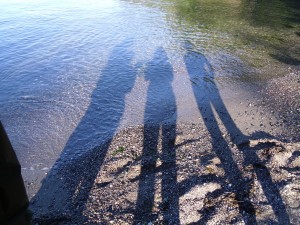
If we do not practice sustainability science now, where will we be in the future?
Read More
 Resource Management
Resource Management






 Twitter
Twitter LinkedIn
LinkedIn Facebook
Facebook